Brands that prioritize their customers will never worry about going out of business. Happy customers are more likely to stay loyal, make repeat purchases, and recommend your products or services to others.
Artificial intelligence (AI) has emerged as a powerful tool to improve how brands approach customer satisfaction.
In this blog, we’ll:
- Explain how AI works
- Explore seven customer-centric AI strategies
- Explain how to use AI securely
What is Artificial Intelligence (AI)?
AI is a computer algorithm that can be trained to perform tasks that typically require human intelligence. These tasks include things like:
- Understanding natural language
- Making decisions based on data
- Recognizing patterns
Brands can use AI’s vast data processing capabilities to analyze customer-related data to make informed decisions and provide better online experiences.
Let’s explore seven methods on how you can implement customer-centric AI into your customer interactions.
1. Personalized recommendations
Brands can instruct AI algorithms to sift through a wealth of customer data, such as browsing history, purchase behavior, and preferences.
The goal? Offer individualized product or content suggestions.
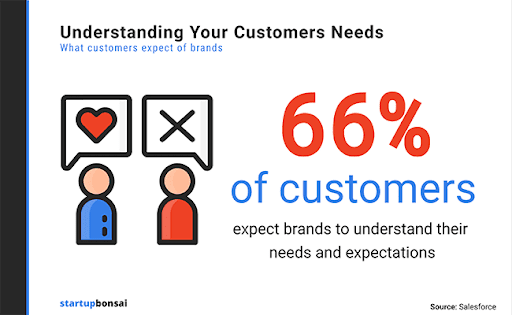
The customer is always right. Understanding their needs and expectations from the first interaction helps the customer find what they need quickly. The result? You guessed it. Better sales opportunities and higher conversion rates.
By presenting customers with items or content they’re more likely to be interested in, brands can effectively cross-sell related products and upsell higher-value options.
Such data-driven decisions are a win-win scenario.
- Customer trust goes through the roof as they discover items that genuinely resonate with their needs and interests.
- Businesses increase their revenue and improve customer satisfaction through a tailored shopping experience.
2. Customer query management
AI algorithms can instantly analyze the content and context of a customer support query.
With the help of natural language processing (NLP), AI can comprehend the query’s intention and importance. From there, it’s great at categorizing it accordingly (such as a request for information, a complaint, or technical support).
The technology can direct it down the proper support path by either:
- Routing it to the appropriate human agent for more complex issues.
- Providing an immediate automated response for simpler queries.
This process drastically reduces response times and guarantees customer inquiries are promptly and accurately addressed.
Over time, the AI system can become more adept at responding to frequently asked questions by learning from previous queries and responses. It can even anticipate customer needs based on similar past inquiries.
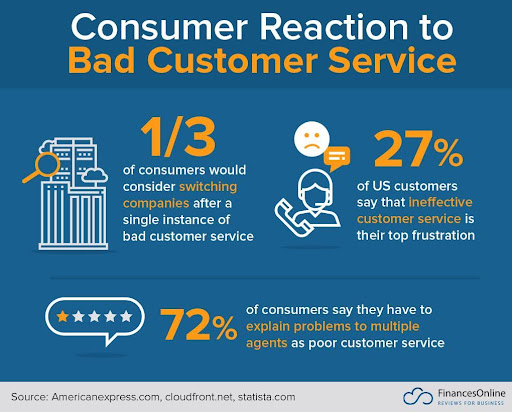
The truth is customer service can make or break your brand. When customers receive prompt and relevant responses, they’re happier and more likely to recommend you to their friends and family.
3. Chatbots and virtual assistants
Chatbots and virtual assistants aren’t new, but when powered by AI, their customer service capabilities are amplified.
AI chatbots learn from customer interactions. They analyze data from past conversations to improve their responses over time. As a result, they become more accurate and helpful as they consume more data (a branch of AI known as machine learning).
When equipped with NLP, they understand human language with all its nuances and handle queries in a more human-like manner.
For example, if a customer typed:
“I bought a blue sweater last month, and it’s too small. Can I exchange it for a larger size, and do you have it in green?”
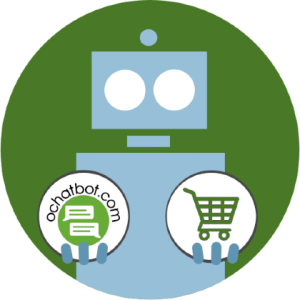
Generative and Scripted AI to engage shoppers in conversational eCommerce.
Create happy customers while growing your business!
-
1 out of 4 shoppers make a purchase on average*
-
5% to 35% Increase in AOV*
-
25% to 45% Reduction in Support Tickets
WE GUARANTEE RESULTS!
A non-AI chatbot would pick up on set keywords like “exchange” and provide a generic response about the company’s exchange policy.
On the other hand, an AI chatbot would understand:
- The fact that the customer bought the sweater last month
- Calculate whether it still qualifies for an exchange
- Check inventory of the size and color of the sweater
- Provide an appropriate response with the product URL
The AI-powered chatbot can also pick up any hint of frustration and dissatisfaction in the customer’s message to avoid generating a tone-deaf response.
For example, it might offer a discount or free delivery on the next purchase to apologize for any inconvenience caused.
Here’s a quick glance at what customers expect from chatbots.
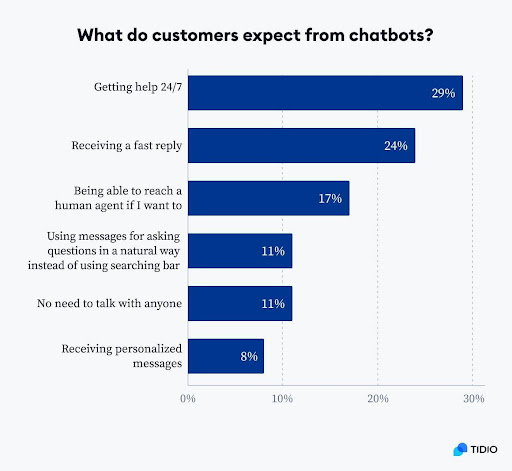
By understanding the context of a customer’s query, generative AI tools vastly improve the customer experience.
4. Sentiment analysis
Brands who want to implement customer-centricity and build strong customer relationships must know how their customers feel and respond appropriately.
The old ways of deriving customer sentiment involve counting the number of times certain words appear across social media channels and product reviews. These methods are outdated and ineffective.
AI-driven customer sentiment analysis quickly helps brands derive valuable customer insights.
For example, a bookstore could plug customer feedback from all sources into a sentiment analysis tool. It’ll highlight the quantity of positive vs. neutral vs. negative comments and the reason behind those scores.
The bookstore might find people are happy with the availability of books but not the delivery times. Identifying and correcting areas of weakness will naturally boost customer engagement.
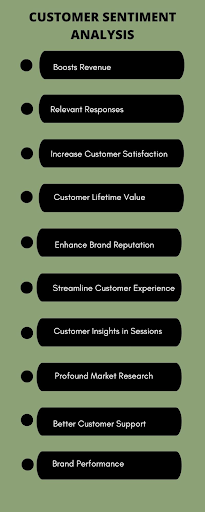
The accuracy of AI sentiment analytics is unparalleled because it understands human slang and sarcasm. These small details allow brands to understand the extent to which customers feel happy/unhappy.
Thanks to the sheer power of AI, this analysis is done at a large scale, at high speeds, and in real time to create a robust customer feedback loop.
5. Language translations
AI breaks down language barriers for brands that serve a global customer base in the following ways:
- Instead of word-for-word translations, it considers context, colloquialisms, and dialect. So, it’s as if the customer is speaking to someone native to them.
- It’s in real-time. A customer’s inquiry can be instantly translated and responded to in their preferred language.
AI language translations are fluid and easy to understand on both sides, drastically reducing misunderstandings while boosting customer loyalty.
6. Enhanced accessibility
AI-driven accessibility tools are designed with sophisticated algorithms that learn and adapt, offering a more personalized and accurate experience for users with different needs.
For instance, AI-powered speech-to-text services can accurately transcribe spoken language into written text, accommodating:
- Speech impediments
- Various accents
- Colloquialisms
This level of precision and adaptability is a leap forward from non-AI speech recognition systems, which often had limited vocabulary and struggled with anything outside of standard speech patterns.
Similarly, AI-text-to-speech services can generate natural and expressive speech far surpassing earlier non-AI systems’ robotic and monotone outputs.
This technology is particularly beneficial for visually impaired users or those with reading difficulties, as it provides a more engaging and easier-to-understand auditory experience.
And because the best TTS tools continually learn from interactions, they can offer a level of customization and effectiveness that non-AI solutions simply can’t match.
7. User behavior analysis
AI algorithms are adept at session replay — the art of scanning and analyzing a wealth of data generated by user interactions on a website.
This analysis includes tracking all aspects of the customer journey, including:
- Where do they hesitate before adding items to a shopping cart
- How much time do they spend on each page
- How they interact with different elements
- How long do they watch videos
- What links are they clicking on
- The pages a user visits
AI can draw insightful conclusions about individual user preferences and interests from this rich dataset.
For instance, AI can detect frequent points of use
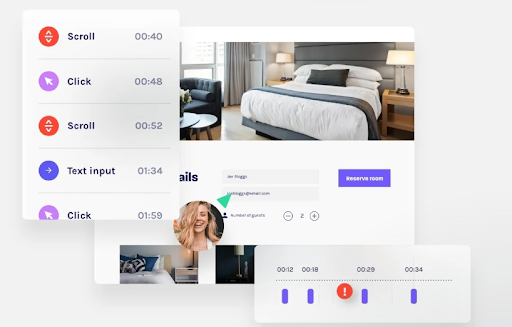
With 88% of customers less likely to return to a website where they experience a bad UX, preventing simple website issues works wonders in boosting customer sentiment.
By automating the analysis of countless user sessions, AI saves time and provides more accurate and objective insights.
Furthermore, AI can categorize sessions based on user behavior. Now, you can access the right data to quickly find and study relevant sessions — like those leading to a purchase or those ending in a user dropping off.
This targeted analysis helps you make data-driven decisions to optimize user experience, improve website functionality, and enhance overall customer satisfaction.
How to Use AI Securely
At this point, it’s clear that customer-centric AI helps you work smarter, not harder, to improve customer interactions with your brand.
However, some customers are cautious about how their data is used to provide these personal interactions.
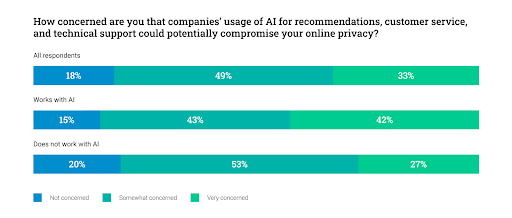
That’s why building the proper security protocols is crucial to enhancing consumer trust in their interactions with your brand.
Not sure where to start? Learning the differences between SAML and OAuth allows you to choose the proper authentication and authorization mechanisms based on your specific needs.
Integrating these protocols intelligently into customer-centric AI solutions can enhance security, streamline user experiences, and improve customer satisfaction in support interactions.
Here’s a quick breakdown of each authentication protocol:
- SAML: In a customer support context, SAML is ideal for enabling seamless access to various support platforms without requiring users to log in multiple times. This protocol can enhance the user experience by reducing friction and providing a unified login experience across different support tools.
- OAuth: You can use OAuth when integrating with third-party applications or services to access relevant customer data for intelligent support interactions. Doing so can facilitate personalized, context-aware, and secure support interactions.
Wrapping up
The seamless integration of AI enhances the customer experience, making it a necessity for any brand serious about adopting a customer-centric approach.
Artificial intelligence (AI) has a big effect on how businesses connect with their customers. It can make interactions more personal, anticipate customers’ wants, and offer fast, 24/7 support.
This sets a high standard for customer engagement and satisfaction. That said, brands that embrace AI are poised to stay ahead of the curve and build an economic moat for future success.
On the other hand, those who neglect to incorporate AI-powered customer experiences into their strategy risk falling behind. Why? They’ll fail to match the personalization, efficiency, and innovation level that AI-enabled competitors offer.
In an era where customer expectations are continually rising and changing, using AI is crucial for any brand aiming to thrive and maintain a competitive edge in the market.

Arif Bharakda is a versatile writer passionate about marketing, technology, and B2B insights. With a keen interest in personal growth, Arif brings a relatable perspective to complex topics, making them accessible to all readers.
- The Rise of Intelligent Websites - February 19, 2025
- Top Trending Products to Boost Your Shopify Store in 2024 - September 4, 2024
- AI Terms Glossary: Key AI Concepts You Should Know - August 22, 2024


